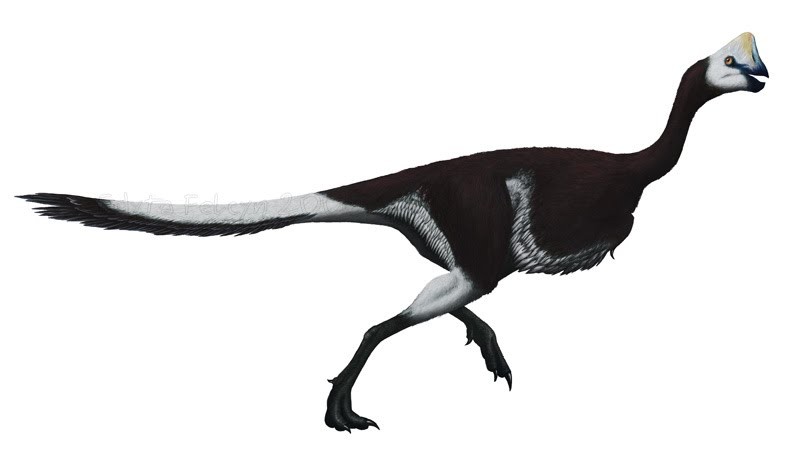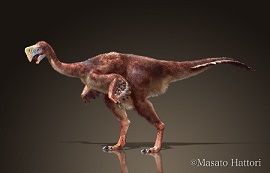
Nemegtomaia is a fascinating dinosaur species that once roamed the ancient landscapes of what is now Mongolia during the Late Cretaceous period, approximately 70 to 66 million years ago. This dinosaur belongs to the theropod group, which includes some of the most iconic predators of the Mesozoic era, such as Tyrannosaurus rex and Velociraptor. Nemegtomaia is particularly interesting due to its unique characteristics and the valuable insights it provides into the diversity and behavior of dinosaurs from this period.
Nemegtomaia was first discovered in the Nemegt Basin of the Gobi Desert in Mongolia in the early 1990s. The name Nemegtomaia is derived from the Nemegt Formation, where its fossils were found, and the Greek word maia, meaning good mother.This name reflects the presence of an egg associated with the remains, indicating a potential connection to nesting or maternal behavior.
| Name: | Nemegtomaia dinosaurs |
| Size: | Around 2 to 3 meters (6.5 to 10 feet) |
| Main Facts: | Nemegtomaia had a distinctive crest on its skull and potentially exhibited maternal care based on a fossilized egg found nearby. |
One of the defining features of Nemegtomaia is its elaborate crest on top of its skull. The crest is relatively large and has a unique shape, resembling a rounded, elongated mound. This distinctive feature has captured the attention of researchers, leading to speculations about its purpose. Some paleontologists believe that the crest may have played a role in communication or recognition among individuals of the same species, while others suggest it could have been used for display during courtship rituals.

Nemegtomaia was a relatively small dinosaur, estimated to have been about 2 to 3 meters (6.5 to 10 feet) in length and weighing around 20 to 40 kilograms (44 to 88 pounds). Its size and lightweight structure suggest that it was agile and may have been a swift runner. As a theropod, it was bipedal, meaning it walked on its hind legs, and had sharp claws on its hands.
One of the most remarkable discoveries associated with Nemegtomaia is the presence of a preserved egg found near the fossilized remains. This finding has led scientists to propose that Nemegtomaia was capable of brooding its eggs, exhibiting maternal care—a behavior not commonly seen in the fossil record of dinosaurs. This remarkable evidence has shed light on the reproductive strategies and social behavior of some dinosaurs.
As with many dinosaur species, the precise behavior and lifestyle of Nemegtomaia remain somewhat speculative due to the limited information available from fossil remains. Paleontologists continue to study and analyze the fossil evidence to gain more insights into its anatomy, behavior, and ecological role.
The diet of Nemegtomaia is thought to have been omnivorous, which means it consumed both plant material and small animals. Its teeth indicate adaptations for processing plant matter, suggesting that it might have fed on ferns, cycads, and other vegetation commonly found in the Cretaceous environment. However, given its theropod heritage, it likely also hunted and scavenged for small vertebrates and invertebrates.
Nemegtomaia belongs to the theropod group, which includes bipedal, carnivorous dinosaurs such as Tyrannosaurus rex, Velociraptor, and Allosaurus. These dinosaurs were highly successful predators and played a significant role in shaping the ecosystems of the Mesozoic era.
Nemegtomaia is a member of the Oviraptorosauria, a subgroup within theropods. Oviraptorosaurs were characterized by their toothless, beak-like jaws and often had crests or other cranial adornments. Other well-known oviraptorosaurs include Citipati and Oviraptor.
One of the most distinguishing features of Nemegtomaia is its large, rounded cranial crest. This sets it apart from many other dinosaurs, including other oviraptorosaurs. For instance, Oviraptor had a distinct crest, but it was different in shape and size compared to Nemegtomaia's.
Nemegtomaia was a relatively small dinosaur, estimated to be about 2 to 3 meters (6.5 to 10 feet) in length and weighing around 20 to 40 kilograms (44 to 88 pounds). In comparison, some other theropods like Tyrannosaurus rex were much larger, reaching lengths of over 12 meters (40 feet) and weighing several tons.
Nemegtomaia's teeth suggest it had an omnivorous diet, consuming both plant material and small animals. This makes it distinct from many other theropods that were primarily carnivorous. For example, Tyrannosaurus rex and Velociraptor were apex predators that primarily hunted and scavenged for meat.
The discovery of a preserved egg near Nemegtomaia's fossil remains provided evidence of potential reproductive and nesting behavior. This characteristic sets it apart from most other dinosaurs, as only a few dinosaur fossils have been found with associated eggs, such as the hadrosaur Saurolophus and some sauropods.
Nemegtomaia lived during the Late Cretaceous period, approximately 70 to 66 million years ago. During this time, the world was populated by a diverse array of dinosaurs. Comparing Nemegtomaia with other dinosaurs from the same time period helps us understand the interactions and ecological roles of different species within ancient ecosystems.